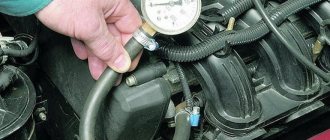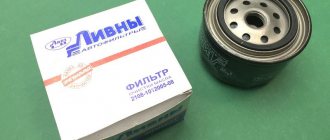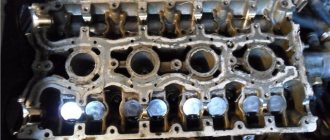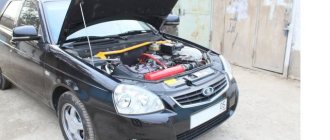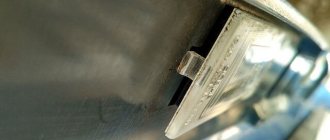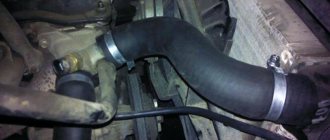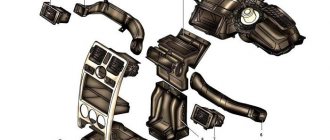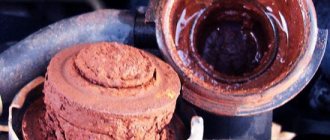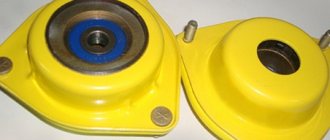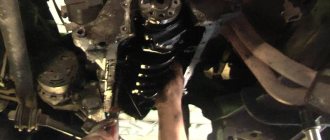Changing the pump on a Lada Kalina: diagnostics, replacement, recommendations
Domestic cars are always in constant demand in Russia. On the one hand, these are affordable means of transportation, on the other hand, their ease of maintenance allows you to carry out repairs on your own. One of the most serious breakdowns of the Lada Kalina can be considered pump defects. Indeed, if the pump is out of order, you cannot operate the car - there is a high probability of the motor jamming. Therefore, Kalina owners should pay special attention to the performance of the pump and the engine cooling system as a whole.
Why do you need a pump in a car?
The pump (or water pump) on the Lada Kalina is a device that circulates coolant. The pump starts working together with the power unit, that is, after the moment of ignition, the pump also starts working.
The circulation of antifreeze/antifreeze in the system is ensured by the rotation of the pump shaft on which the impeller is located . The impeller blades create the necessary fluid pressure, due to which the motor is cooled uninterruptedly. However, if there are any defects in the pump, antifreeze stops being supplied to the cylinder blocks, so the engine can “boil” and fail. Therefore, for high-quality and timely cooling of the engine, it is necessary to monitor the condition of the pump.
Original pump, which is installed on the Lada Kalina
Main reasons
Before talking about the signs of a dying pump that needs replacement or repair, you need to say a few words regarding the reasons for the failure of this device.
In total, there are several main factors that cause this to happen:
- Using low quality antifreeze. About 90% of pumps break down precisely because of this. Such a cooling liquid contributes to the appearance of tarry deposits, which makes the impeller difficult to rotate;
- Corrosion. Again due to low-grade antifreeze;
- Cavitation, that is, the formation of vacuum bubbles that can literally tear out pump particles and destroy the mechanism;
- The result of normal wear and tear. Each device has a limited resource. The best samples last about 200 thousand kilometers;
- Broken fastening. It's simple. The fasteners became loose, the pump became loose and fell apart.
In most cases, it is the car owner himself who is to blame. Drivers are required to monitor the condition of the cooling system, periodically check the pump, and change the coolant on time.
We cannot exclude the problem of manufacturing defects, as well as simply low-quality and cheap pumps that are installed on budget cars or as part of repairs, thereby deceiving the client.
It is not surprising that the timing belt may then fail, the tension roller may rupture, the cylinder head gasket may break through, and other troubles that can cost a lot of money during repairs.
We recommend: How to replace brake discs on a VAZ-2114 yourself
Problems with the water pump can occur on various cars:
- on Kalina;
- VAZ 2110;
- Lada Priora 16 valves;
- VAZ 2114;
- Lada Priora 8 valves;
- VAZ 2115;
- Daewoo Lanos;
- Niva Chevrolet;
- Daewoo Nexia;
- Lada Granta;
- Renault Logan;
- Chevrolet Aveo, etc.
Don’t think that this is a problem exclusively with cheap and budget cars, as well as simple engines like ZMZ 406.
The pump can also be used on more expensive cars. It all depends on how the owner monitors and maintains the car with his own hands, or in a car service center.
How to determine if the pump is faulty on Kalina
The first sign that the water pump on a car has started to work incorrectly can be considered extraneous noise in the engine compartment while driving.
Lada Kalina cars are equipped with water pumps with a strictly fixed service life - 60 thousand kilometers or 48 months of operation (whichever comes first). Therefore, when this period approaches, it is recommended to change the pump, even if there are no signs of malfunctions yet.
However, in some cases, the pump may fail earlier than stated. You can check the functionality of the water pump in the simplest way:
Warm up the engine to the optimal temperature. After warming up, use a gloved hand to pinch the upper pipe that comes from the radiator.
If the pump is working properly, you will immediately feel the fluid pressure in the nozzle. Accordingly, the pump works as coolant circulates through the system.
If pressure is felt, but weak, or not at all, it will be necessary to proceed to a detailed inspection of the pump.
You will have to remove the timing case and visually assess the external condition of the pump.
If there is a leak of antifreeze at the landing site, it means that the oil seal (seal) has failed.
If a roar is heard while driving, we can conclude that the pump shaft bearing has worn out. You can pump the drive part of the pump gear by hand. If there is play, the pump will not work correctly.
Loss of pump tightness leads to disruption of fluid circulation in the system
Thus, it is possible to identify pump malfunctions without removing it from the car. The procedure is quite simple and accessible even to a novice driver.
Pump Lubrication Procedure
When drivers talk about lubricating the pump, they mean lubricating the water pump bearings. There are two bearings installed on the shaft, which require a small amount of lubricant to operate correctly. Experienced drivers lubricate the pump without removing it from the car:
Remove the gas distribution casing.
Clean the pump mounting area and the pump housing itself from deposits, dust and dirt.
Apply Litol-24 or VNIINP-207 with your finger to the joints of the housing.
A better lubrication procedure will be carried out during pump repairs, when faulty parts are replaced. However, this procedure can also ensure a normal amount of lubricant in the bearings:
In principle, it is possible, but it is not convenient to remove the oil seal. Remove the oil seal and lubricate the cage with warm lithol, it covers the balls there but there are slots in it, so it will still get on the balls, although there may be lubricant there
A N
https://www.lkforum.ru/showthread.php?t=49205
What is better, change the pump or repair it?
Please note that if there are no external signs of problems with the water pump, but the pump has not been changed for a long time or low-quality coolant has been used, then an inspection of the device from the inside is necessary. The fact is that the pump blades can be made of metal. As a result, corrosion forms on the blades. Also, the blades can be made of plastic or other materials, which leads to mechanical failure.
As for repairing the pump, it is possible to carry out this procedure, but it is extremely impractical due to the affordable cost of this unit for most cars of domestic and foreign production. It is also not recommended to repair the coolant pump on cars where it is driven by a timing belt, since the repaired part may be less reliable than a new pump.
You must also observe the recommended tightening torque for the pump mounting bolts. This is necessary in order not to damage the threads and not to compress the gasket. The completion of all work is considered to be filling with antifreeze. If a sealant was used, then you need to wait a couple of hours before adding coolant to the system so that the sealant has time to dry. Next, air pockets are removed from the cooling system, and the liquid is added according to the level. Some time after starting and warming up the internal combustion engine to operating temperatures, you should inspect the pump seat for possible leaks.
When to check the thermostat: the main signs of failure or malfunction of the element. Place of installation of the thermostat and its independent check.
How to independently determine that the cylinder head gasket has burned out. Recommendations for pulling the cylinder head after replacement. Which gasket is better to choose?
What can knock, whistle, rustle and make other extraneous sounds under the hood after starting the engine. Diagnostics and determination of faults.
Why does the engine overheat? What should the driver expect and what damage may occur if the engine overheats. What to do if the internal combustion engine overheats.
Reasons why coolant starts to leak. How to find the location of an antifreeze or antifreeze leak yourself. Useful tips and tricks.
Pump device. The operating principle of a centrifugal pump, an engine cooling system with two pumps and a switchable pump. Pump malfunctions and repairs.
Source: krutimotor.ru
Replacing the pump on a Lada Kalina (8 valves)
On an 8-valve Kalina, you can change the water pump yourself. However, if the car owner does not have minimal experience in car maintenance, many questions may arise. For example, which pump to buy, how to choose the right tool, and is it worth draining the antifreeze from the system completely?
Which pump to choose
When the time comes to change the water pump, car owners begin to look at car dealerships for a worthy replacement. But which pump to choose so that it lasts as long as possible and does not cause problems for the owner?
It is important to choose original factory products. This is immediately evident from the packaging - an uncreased box, a warranty card, the date of manufacture and service life are indicated. Original pumps are necessarily packaged in protective film and have holographic stickers.
In contrast, it will not last long - after 10 thousand kilometers the pump will need to be changed again.
At AVTOVAZ, designers install a TZA water pump on the Kalina. It has a long service life; drivers often change the pump only after 100 thousand kilometers. As an alternative, you can install more expensive German-made Bosch pumps - they are also famous for their quality and durability.
Where is the water pump located on Kalina?
Due to the fact that the pump is driven by the timing belt, it is part of the gas distribution mechanism. That is, you need to look for the water pump on the Lada Kalina from the side of the engine itself. Visually, before removing the belt, you can only see the pump pulley, which is involved in the gas distribution system.
The pump on the VAZ is located in the timing device
Preparing tools
It is recommended to prepare a standard set of tools for removing bolts and unscrewing nuts. You will also need a 6-point hex key. To drain the antifreeze without contamination and inconvenience, it is better to immediately find a container for draining and a rag to blot up any drops that have fallen on the engine elements. To ensure reliable installation of the pump, you can use a sealant with good thermal conductivity properties.
How much coolant to drain/fill when replacing the pump
In any case, before dismantling the old pump, you will need to drain the antifreeze from the system. This is necessary in order to reduce the pressure in the hoses and not be injured during sudden releases of liquid.
If the water pump has not been changed for a long time, then it is advisable to immediately drain the entire volume of antifreeze from the system and replace it with a new one. If the car owner has recently filled in new coolant, then there is no point in completely draining it: just disconnect the hoses from the expansion tank and wait until the antifreeze comes out.
To make it easier to fill a large volume of coolant, drivers usually use funnels
Operating procedure
First of all, you will need to install the machine on a flat surface. You can drive the Kalina into the inspection hole, you can simply lift the front right part on a jack. It is recommended to make sure that the car is securely secured; it is better to place additional supports under the body beam.
Replacement
You can replace the pump yourself; for this you will need: a 10mm socket, wire cutters, a screwdriver, a 6-corner bit, and a small ratchet.
- We drive the car onto the overpass, unscrew the crankcase and engine protection, thereby freeing access to the engine. Open the hood and unscrew the cap on the left side of the radiator and drain the antifreeze. If you plan to refill the same liquid, then place a bucket under the radiator.
- We look for a bolt on the front part of the cylinder block and unscrew it. We also drain the antifreeze from the engine into a bucket.
- We remove the plastic decorative trim on the engine; to do this, you just need to pull it up.
- We connect the ratchet with the bit and unscrew the bolts holding the front timing belt cover.
- We align the upper pulleys according to the marks on the rear timing belt cover.
- We unscrew the two timing belt tensioner rollers.
- Remove the belt and gear.
- We unscrew the two upper toothed pulleys and then pull them out.
- Using a 10mm socket, unscrew the 6 bolts on the rear cover of the timing gear drive and pull it out.
- Armed with a ratchet, unscrew the 3 screws securing the pump.
- Using a screwdriver, use a screwdriver to pry up the pump and remove it.
- We clean the pump seat from dirt and remnants of the old gasket with a dry cloth.
- On the new pump, lubricate the gasket seat with a small amount of sealant.
- We put on the gasket and also lubricate it.
- We install the pump on the engine so that the hole in its body looks down into the nearest hole to the filter.
- We tighten the bolts holding the pump.
- The pump has been replaced. We assemble all the parts in reverse order. Don't forget to add coolant.
At the slightest sign of pump malfunction, it is recommended to inspect and replace it. Otherwise, the car's cooling system will be disrupted and engine overheating will be inevitable. And its repair will require more serious financial investments.
How to connect an additional pump on the Lada Kalina
Most modern cars have two water pumps installed at once. This ensures the highest quality engine cooling in any operating conditions. You can also install a second (additional) pump on the Lada Kalina, and this work takes a little time and effort. The most difficult thing is to get to the place where the pump is fixed, since you will have to disassemble many engine compartment parts.
An additional pump is needed not only for high-quality engine cooling. Mostly, Russian car owners install a second pump to improve the operation of the heater in the cabin during the winter - the car warms up faster.
In order to install the second pump on the Kalina, you will need:
hoses of different lengths;
fasteners (depending on where exactly it will be easier and more convenient to screw the pump);
The essence of the work is to organize a small circle of coolant circulation throughout the system.
Doing the work yourself
The first step is to assemble the assembly itself from the materials that are at hand. The pump is connected to two hoses (the short one will provide fluid removal, and the long one will provide supply). The hoses are attached to the two ends of the pump with clamps. Then follow the following procedure:
- The coolant will need to be drained. You can simply empty the expansion tank without draining the entire volume of antifreeze.
- Near the bottom of the car, find two hoses (one leads the antifreeze to the stove, and the other takes it away from it). Disconnect the outlet hose and instead attach the assembled structure with an additional pump.
- After this, attach the pump to the gearbox housing. Depending on the availability of fasteners, you can place the device on brackets or secure the pump with metal clamps.
In this case, the hoses are connected with clamps, and the pump itself is mounted on a metal bracket
At the end of the work, you will need to plug all hoses and plugs and fill in new antifreeze.
Video: second pump - preparation and installation
Thus, on Lada Kalina cars, the owner can independently change the water pump without resorting to the help of service station specialists. This will save money and also allow you to independently control the operation of the pump, taking into account the knowledge about the state of the machine system that was obtained during operation.
Source
Checking the pump without removing it
In some cases, you can check it without removing it: there are a number of faults that can be seen. To do this, discover the pump and then check each point:
- Backlash. If all the parts shake (or at least the pulley), then it’s time to change the part.
- Antifreeze leak. Inspect the device for signs of leaks. If they are not there, they must be elsewhere in the cooling system.
- Failure is also determined when the bearing whistles. This whistle is difficult to confuse with something: it either becomes louder or “fades away.” But keep in mind that a similar whistle can be caused by a broken generator.
How to replace the pump on a Lada Priora 16 valve car is shown in detail in this video:
Required Tools
Before replacing the Lada Priora pump, prepare a number of tools:
- Keys for 10;
- Hexagon "5";
- Flat screwdriver;
- Torx T-30 (belt removal);
- Head wrench “17” (belt removal);
- Socket or cap wrench “15” (belt removal).
How to check a pump on Kalina 8 valves
Quite a lot of car owners are wondering how to check the pump without removing it from the engine.
After all, it is highly not recommended to mess around with the cooling system, so it’s worth learning how to check it directly on the car. Please note that this will minimize repair time and also make it possible to avoid unnecessary costs for unnecessary components. Even a completely inexperienced driver can carry out such diagnostics, which will make his task easier, especially if the engine suddenly heats up. Do not delay carrying out diagnostic work; remember that overheating of the power plant leads to its rapid failure. How to check the pump without removing it from the engine is actually a fairly simple question. There shouldn't be any problems with this. But, you need to know how this system works. Careful study of the work process will greatly simplify the diagnostic process. Another point that should not be forgotten is the ability to carry out such diagnostics at any convenient time. Even if you are on the road in a deserted area, you can conduct a check and decide on further movement.
Technical features
First, let's look at the main technical characteristics and features of the water pump; this will allow us not only to make a correct diagnosis, but also to understand why the breakdown occurred.
Antifreeze is pumped using an impeller, which is mounted on a shaft. The drive is carried out from the crankshaft of the motor; a belt drive is used for this. Here it is worth clarifying that in practice there are 2 drive methods used for the pump:
- Directly from the crankshaft
. This method is used on engines with a timing chain. Usually one belt drives the generator and pump, sometimes the power steering and air conditioning pump are also connected here; - Another option is timing belt drive.
There is one serious drawback here. When the bearing jams in the pump, the belt breaks, which leads to breakdown of the gas distribution system, and under certain conditions, to a complete overhaul of the engine. In this case, you should carefully monitor the condition of the pump.
The pump housing is usually located at the front of the motor. This allows for the most optimal pumping of coolant through the system. It is also precisely this approach that makes it possible to use the crankshaft pulley as a moving element. In addition, placing the part at the front makes it easier to access for repairs.
The main malfunctions of the pump are directly related to its technical features; accordingly, this must be taken into account when carrying out diagnostic actions. As a rule, all signs of a malfunction are completely related to the characteristics of the various elements that ensure the operation of your car's cooling system.
Pump design
Let's look at the water pump up close!
- This device is located in a housing made of aluminum, inside which a roller rotates in a double-row bearing, the lubricant of which is sufficient for the entire period of operation of the pump. The outer ring of the bearing is locked with a screw.
- The toothed pulley is pressed into the front of the roller, and the impeller is pressed onto the reverse side. The impeller is also secured with a retaining ring made of graphite-containing materials.
- Such a one-piece design of the device will not allow repairs. And when a pump malfunction is detected (play, etc.) - only replacement.
Car behavior with a faulty pump
When the pump is faulty or its operation occurs with some difficulties in the operation of the engine, changes may also be observed:
- Poor circulation of coolant, as a result of which the car heats up faster and cools slower.
- The coolant level drops.
- Bearing noise in the engine compartment.
Signs of a fake pump. This is clearly not the famous Gates
Pump performance test
In order to make sure that the pump is fully operational, you can perform one very simple test. To do this, you need to warm up the engine to operating temperature, and then touch the upper radiator pipe. So, if the liquid circulates properly in the system, you will feel it with fairly intense movements inside.
How to check?
An important point is to check the pump. Many car enthusiasts believe that in order to diagnose it, it is necessary to dismantle the part, but in most cases you can do without this. There are a number of signs by which you can understand that the problem is in the pump. To begin with, it is worth noting that most manufacturers recommend replacing the water pump after 60-80 thousand kilometers
. In some cases, regulations indicate the need to replace simultaneously with the timing belt. Therefore, if the pump on your car has gone through such a mileage, then it makes sense to replace it at the first opportunity.
avtoexperts.ru
The pump is a spare part of the invisible front. It works in the bowels of the engine, ensuring its cooling, and the results of its work are visible only by the arrow reading on the coolant temperature indicator. The pump is also insidious, it is a relatively inexpensive spare part (although the price depends on the specific car model, some are expensive), but changing it is expensive, because for this you have to disassemble a lot. This is especially felt on cars with a timing belt drive, because most often in such cars the timing belt turns the pump. But even in those cars where the drive is a separate belt, there is still a lot of hassle in replacing the water pump.
This feature has developed a certain rule among reasonable drivers - it is better to change the pump at the same time during large-scale maintenance or other work (most often this is replacing the timing belt) than to then change the water pump separately. The cost of replacing a pump with the timing drive removed is an order of magnitude cheaper than separate work to replace only the pump. Some drivers prefer to generally change the pump every time the belt is changed (for example, once every 60-80 thousand kilometers), but this seems like overkill. The service life of a pump is an unpredictable thing, it depends on the specific model, proper operation (pumps really do not like other types of antifreeze, as well as various mixtures) and simple luck. Even on the same car model, pumps fail at different mileages, literally from tens to hundreds of thousands of kilometers.
In order not to overpay and not change a part that can still serve and serve, we would suggest adhering to the following algorithm: with every serious disassembly of the gas distribution system or other large-scale work in the pump area, be sure to check its condition. If there is even the slightest sign of malfunction, then replace the pump preventively. Yes, maybe it would still serve, but the fact that it would last until the next large-scale work is no longer a fact. If there are no questions about the water pump, then you can let it work for another period.
So how can you spot signs of trouble?
1. Warm up the engine and, with the engine running, pinch the upper hose from the radiator by hand. A strong and rhythmic pulsation of coolant should be felt in the pipe. If the pulses are weak, infrequent, or absent altogether, this is an indication to replace the pump. For example, the impeller of a water pump may begin to fall apart. For the time being, this will not be noticeable, but the efficiency of the cooling system will inevitably decrease and the engine may boil under load. The verification method is, of course, somewhat subjective, but it has proven its right to life.
Possible faults
Now let's look at the main malfunctions of the pump; all problems have their own signs, knowledge of them will allow us to make more competent diagnostics. So, most often drivers face the following reasons:
- Depressurization of a part
. In this case, the coolant leaves through the shaft seal or through the gasket. Here there is a decrease in the efficiency of the pump; part of the pressure is lost due to a leak. With such a malfunction, antifreeze drips are often observed, and it also quickly leaves the system; - Bearing wear
. The shaft on which the impeller is mounted has a bearing, which wears out over time and may fail. Bearing jamming, as already mentioned, on some engines can lead to a number of serious breakdowns. It is worth considering that this problem can manifest itself in different ways. Most often, the bearing begins to howl, this is due to the depletion of lubricant, as well as a high level of wear of the race. But sometimes a breakdown manifests itself as a knock. This happens when the bearing is completely or partially destroyed. Another possible malfunction is a jammed bearing, in which case the pump cannot be turned; - Impeller destruction
. This is a rare malfunction, but it does happen. The reason is the poor quality of the part. With such a breakdown, a strong roar is observed immediately after starting the engine, and the car quickly overheats.
Signs of trouble
I would like to immediately note that in order to determine faults in the water pump, you will need to remove the unit and disassemble it. Only this method provides a real opportunity to see the resulting traces of corrosion, signs of cavitation and contamination.
Practice clearly shows that this happens on a wide variety of machines:
- VAZ 2107;
- Volkswagen Passat;
- FF2, that is, Ford Focus 2nd generation;
- Lada Granta;
- Kia Spectra;
- Chevrolet Aveo;
- Audi A5;
- Nissan Qashqai;
- Mitsubishi Outlander;
- Toyota Camry;
- Skoda Octavia, etc.
Moreover, the situation is approximately the same everywhere. That is, it is impossible to determine whether there are problems without disassembling and looking inside the cooling system water pump.
Therefore, the main emphasis is on indirect signs. With their help, the driver gets the opportunity to diagnose the problem in advance and prevent serious consequences.
The following indirect signs are distinguished:
- A thin whistle appears without interruption during engine operation. Moreover, it comes from the area of the camshaft pulley of the internal combustion engine. A whistle indicates that a higher bearing is failing;
- Coolant leaks. Traces of antifreeze can be seen directly on the power unit, or under the bottom of the car, that is, on the asphalt;
- Pump play. To check for its presence, simply grab the pump pulley with your hand and try to swing the device up and down.
Do not forget about the possible airing of the system, due to which the antifreeze does not fully perform its functions, the engine overheats and a number of resulting breakdowns occur. Here it would be correct to remind you about removing the air lock from the cooling system. Also, be sure to read the material about checking the cap of the expansion tank, which is directly related to the engine cooling system.
I won't talk about how the pump changes. Usually replacement is carried out according to the owner's manual from the car manufacturer. The point is to drain the cooling liquid, disconnect the pipes, first turn off the power to the car, and dismantle the problem unit.
The design and location of all pumps are different, therefore there is no universal instruction. You can find a video online, or simply take the car to a car service center.
We recommend: Purpose, design and specifics of operation of an automobile driveline
How to fix the problem?
If a malfunction is identified, it should be eliminated as soon as possible. Here it is worth understanding that the pump is still a consumable, and in most cases it is easier to completely replace it.
If there is a leak through the gasket, simply remove the pump and replace the gasket. Please note that normal tightness is required here. Therefore, be sure to carefully tighten the fastening nuts. Many drivers lubricate the gasket with sealant; such a precaution will not be superfluous. This will significantly reduce the risk of leakage. After some time, you should check the tightness of the nuts; they may loosen due to engine vibration.
If the cause is the bearing or impeller, then the best solution is to replace the water pump. Repair in this case is complicated, but its effectiveness is low, so it is better to buy a new part and install it. Don’t forget to bleed the cooling system after replacing the pump; this will remove all air pockets, which will increase its efficiency.
conclusions
. The cooling system must operate at maximum efficiency, otherwise engine problems will occur. Therefore, it is simply necessary to know how to check the pump without removing it from the engine. This will avoid costly repairs to the power unit and save you a lot of money.
| The heater does not heat well, the coolant level drops below the MIN mark each time, the engine temperature does not rise to operating temperature, or the engine overheats? The causes of all these ailments are improper operation of the engine cooling system (ECS). We learn to identify and eliminate the causes of poor performance of the LADA Kalina SOD. |
see also
Which pump should I put on my car?
- 165 29 147k
water pump
- 0 2 121k
Determining pump faults
- 28 1 54k
Malfunctions of the pump are manifested in significant play in its shaft, violation of the tightness of the seal, wear (corrosion or breakage) of the impeller. All of these defects lead to the fact that the car’s water pump does not work properly, which is why the required pressure is not maintained in the engine cooling system, which, in turn, leads to an increase in the temperature of the coolant until it boils. You have to buy a new pump and install it in place of the old one.
Diagnostics of the LADA Kalina engine cooling system
When operating a vehicle, the technical condition of the cooling system can be assessed by looking at the coolant temperature gauge and the fluid level in the expansion tank. A decrease in coolant level is usually caused by a leak in the system. Some cars have a coolant level sensor installed. When the level drops to the MIN mark, the corresponding indicator lamp in the display unit of the on-board monitoring system lights up.
| 1. Checking the coolant level in the expansion tank . The liquid level should be 25 - 30 mm above the MIN mark on the expansion tank body. If the fluid level is at the MIN mark or below, add coolant to the reservoir |
Warning!
| The coolant level should be checked on a cold engine. A slight increase or decrease in the coolant level during heating and cooling of the engine is not a malfunction. This is due to the thermal change in the volume of the liquid. |
If you have to regularly add coolant, you should check the tightness of the cooling system.
2. Check the tightness of hoses and connections of the cooling system . Inspect the engine compartment and pay attention to the condition and tightness:
- Expansion tank hoses;
- Radiator drain holes and hoses;
- Heater radiator hoses;
- Engine cylinder block;
- Places for installing temperature sensors;
- Thermostat hoses.
3. Checking the integrity of engine cooling system elements.
- Expansion tank housing;
- Engine radiator;
- Heater radiator;
- Connections between the coolant pump (pump) and the cylinder block. We also check that there is no leakage of liquid from the drainage hole of the pump (located at the bottom of the pump), indicating wear of its seal.
There should be no coolant leaks anywhere.
| 4. Checking the thermostat . We control the coolant temperature using the indicator on the instrument panel, and the circulation of the liquid in small and large circles by touch, by changes in the temperature of the hoses and pipes of the cooling system (in the photo the air filter is removed for clarity). |
Comment
| If the engine cooling system is working properly, then when the coolant temperature is less than 90 ° C, the main thermostat valve should be closed and the coolant should circulate in a small circle. As a result, the lower radiator hose and the radiator itself will be noticeably cooler than the thermostat housing, through which hot coolant circulates. When the coolant temperature reaches about 90 °C, the main thermostat valve will open and a gradually increasing flow of hot liquid will begin to flow into the radiator. In this case, first the radiator and then its lower hose will begin to heat up. |
Checking the condition of the water pump
Checking the pump on a car is not that difficult. First, you need to warm up the engine so that it reaches operating temperature. After this, follow these steps:
- Pinch the upper pipe at the radiator outlet with your hand. When the pump is working, you will feel the pressure it creates. Be careful during this task as coolant temperatures are typically 90°C or more. If the antifreeze in the system does not pulsate or the pulsation is barely felt, perform a more detailed check.
- It is necessary to remove the timing mechanism protection and inspect the pump visually. Sometimes coolant leaks, which can be caused by a damaged seal, are immediately visible. In addition, signs of pump malfunction may include grayish or red-colored deposits in the area where it is located. In this case, the part will have to be removed.
- If you hear the characteristic sound of a faulty bearing while the motor is running, you need to check the pump for play in the shaft area. Just rock the pump drive gear. Sometimes everything is “cured” by simply replacing the bearing.
Description of the design and operating cycle of the pump
Passenger cars are currently equipped with a hydraulic pump that operates on a centrifugal principle. The task of the element is to ensure continuous movement of the refrigerant. Some pump components are located in hard-to-reach places, so an experienced driver should be able to identify the defect without removing the pump.
The device is housed in a durable metal case and consists of the following functional components:
- Bearings : have a limited resource, as they are lubricated with a pre-applied lubricant. On the other hand, they are completely closed to other components, so they take on a minimal part of the impact of negative factors.
- Axle : this element is fixed using the bearings described above.
- Impeller : the main functional element of the unit. Made of metal to ensure the required strength parameters. Continuously rotating, the impeller pumps up the required pressure in the coolant circuit.
- Pulley : transmits rotational impulse directly from the crankshaft to the impeller. Thanks to the pulley, the operating range of rotation of the impeller is maintained. The use of a pulley is beneficial from a design point of view: slippage of the drive belt is minimized.
Now let's schematically describe how it all works. The cooling pump is connected directly to the crankshaft via a belt. From it the device receives a rotational impulse and spins up to the desired range. The rotating part, with the help of wings, pumps up the necessary pressure and forces the coolant to continuously move along the cooling jacket.
How to monitor the functional condition of the pump?
This is the key difficulty of the issue under consideration: the “symptomatic range” for the imminent failure of the cooler is extremely meager. For most drivers, a pump breakdown becomes an unpleasant surprise, as car owners do not know how to identify signs that can help determine the imminent “death” of the unit. Let us immediately note that the pump cannot be repaired. The only way to restore the functional state of the cooling system is to install a new unit.
According to automakers, the pump should run smoothly for 180 - 200 thousand km. However, they change it earlier - during routine or major maintenance of the timing belt (usually they do this: replacing the timing belt is accompanied by replacing the cooling blower). When approaching the specified mileage interval, we recommend paying attention to extraneous sounds in the engine compartment. A worn-out pump makes cyclic clicking sounds, sometimes grinding. The driver can independently change the service interval: most “experienced” drivers are convinced that the pump needs to be changed at 80 thousand km in order to minimize timing belt wear.
Causes of malfunction
The following reasons are identified that affect the deterioration of the mechanism:
- Damage to the rotating components of the impeller : during intensive operation, small wings of the rotating part break off. This is especially true for plastic impellers. When the wings break off, the pump can no longer pump antifreeze at the required intensity - the engine constantly overheats.
- Drain hole clogged . This problem leads to the fact that antifreeze cannot fully circulate through the circuit. Clogged drainage can be easily tracked without removing the pump. If you suspect that the drain holes are clogged, simply turn on the cabin heater.
- De-synchronization of element and timing pulleys . In this case, the seals and bearings work in extreme conditions and wear out extremely quickly. The reason for such a breakdown is a manufacturing defect: either low-quality materials were used during assembly, or an unreliable assembler was used.
We need to speak in more detail about the third reason. No car owner is insured against manufacturing defects. But in this case, everything is serious with the prefix “hyper”. If you install a pump with potential out of sync, then the use of such a defective unit will lead to a sharp increase in timing wear. In the best case, the driver may encounter a broken belt, in the worst case, the valves “knock”.
Another marker of wear (which, however, can only be seen after disassembling the mechanism) is play in the rotating parts. Backlash indicates imminent failure of the pulleys, displacement of the central axis and damage to the seals.
The last life hack for motorists who do not want to remove the pump, but want reliable information about its functional condition. Carefully inspect the junction of the cooler and the internal combustion engine. If there are significant antifreeze leaks, then the water pump does not have long to live.
Reasons for pump failure on a VAZ-2112
The main signs of a pump malfunction are as follows:
The main reason for pump failure is play on the drive pulley of the entire structure, because of this the pulley begins to simply dangle . This directly indicates wear of the internal bearings and rapid failure of the entire pump as a whole. Such a defect is very easy to detect by touch, and with the timing belt removed, turn the pump pulley by hand and swing it in one direction or the other. If there is play on the pump, you will feel it immediately.
